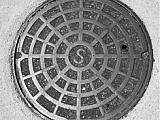
Manhole Covers
January 23rd, 2013
Manhole covers are the ports of entry to the underground world of pipes and mains and cables that transport light, power, heat, and water, in addition to carrying messages and removing waste.
Transcript
Manhole covers are the ports of entry to the underground world of pipes and mains and cables that transport light, power, heat, and water, in addition to carrying messages and removing waste.
The passport to these ports of entry is a crowbar. Most manholes are soot-coated brick or concrete-lined cubicles with just enough room to stand and turn around. The oldest and largest of the city’s subsurface operations is the sewer system. Thousands of manholes lead to sewers lying beneath city streets.
Their cast-iron covers are 24 inches across, and “S” (for sewer) is centered within gridded concentric circles. Under the cover is a four-foot diameter hole about nine feet deep. At the bottom is the sewer drain, which is made of concrete or fired clay. They range from 9 inches in diameter up to a 12 by 15-foot tunnel that bordered the Grand River from Leonard NW south to the disposal plant on Market.
Many distinctive manhole covers are found around the city. Here are just three of some possible examples: a lone “W”, also within gridded concentric circles identifies the water system; a diamond pattern, with its name, marks Consumers Power; STEAM, which identifies the steam mains, has double lids separated by an air space to keep the steam hot and under pressure.
Now when walking past manhole covers, be observant; see how many city services you can identify.
Full Details
| Title | Manhole Covers |
|---|---|
| Creator | |
| Keywords | WYCE; radio; Grand Rapids; Historical Commission; history; utilities |
| Duration | 2:12 |
| Pubdate String | January 23rd, 2013 |

 facebook
facebook